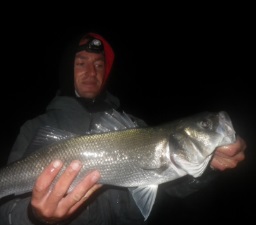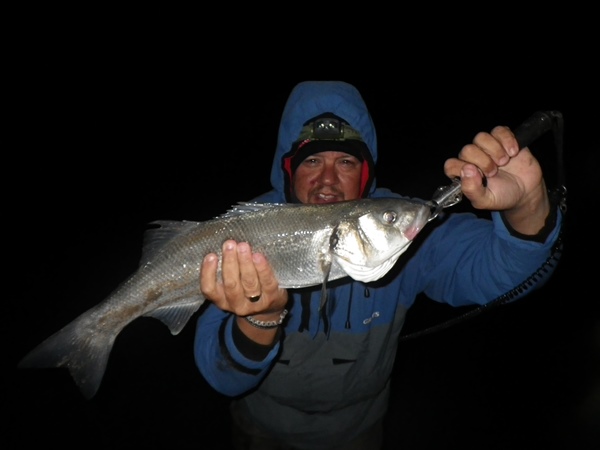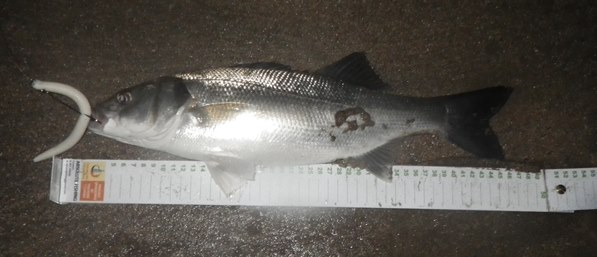One of our BASS members, Rod Lugg, shares some of his experience, top-tips and thoughts on …..
Fishing for bass with Senkos in the dark:
Ease into your environment – In terms of fishing in the dark in general, I do as much if not more as in daylight, I think this as a starting point cannot be underestimated, you need to be comfortable at night – I wouldn’t laugh at people who are afraid of what’s not there, but I’d assume it doesn’t help your fishing if you are jittery. Vision will be minimal to non-existent depending on moon/stars or ambient light levels, so you must be very familiar with your tackle set up, feel and sound will, or should become your primary senses.

Controversial? … forget dusk – fish it black as you can get it. I believe that the popular
belief that dusk is ‘best’ can be overplayed. At dusk I just sit down and wait. Every time I ignore dusk, I catch bass. You splash lures into the water on your mark at dusk, forget the night fishing. If you can’t wait to chuck a lure on a mark, watch news at ten, THEN go out. My theory is that the bigger fish move in at dusk to hunt the shallows, lures plopping around them could possibly spook them, we catch them in the dark so they must get braver under the cover of darkness. So I rest the water at dusk and imagine the hordes of bass are moving in just for me! How many pictures have I got of dusk fish? None! How many in pitch black? LOADS! I have fished dusk enough to know that for me, it’s not that productive – so be brave (read disciplined) and sit it out, no matter how excited you are
Water – flat calm, or for surf beaches, as flat as it gets. It should open up fishing to the times you thought you couldn’t go. More experimentation for me in different conditions may yield a different viewpoint in the future.
Retrieve rate – slow – excruciatingly to moderately painfully slow – no twitches, no sink n draw – just drag em back slow – the undulations in the ground under them will impart some action. You can fish whilst sleeping standing up, (ideal for festivals ), the fish will wake you when they are there!
Review the action – Look at how they move whilst you practise in daylight, they are stunning to watch. Try putting your bail arm back over the instant the lure hits the water – imagine the silhouette of the lure from below – bass will not be able to resist this on a long, slow retrieve. Remember bigger fish are deemed lazier than the faster schoolies and will not compete with them – so a slow bait is attractive to them.
Colour – try them all. Top three in my experience are white, watermelon/pearl and black.
Fluoro leader – yes, whatever you generally use, but over clean sand you could palomar braid to the hook I guess – give it a try!
Clip – yes but a better action can be found on the Rapala knot – you might (or the fish might) beat up the worm, but the hook should do for a session – just re-rig a fresh worm on the hook (I use Lunker City Texposer 4/0 or 5/0 ). If you have to re-tie a knot, you have to!
Rod – use a soft plastics rod, you will feel so much more. A fast bass poker may affect your hook up rate. I’m not convinced rod length makes any difference – I use 8ft 2, others I fish with use rods up to 9ft 7! Clearly the longer rods will give greater casting distance which covers more ground, but all my hits have been relatively close in.
Wade – if you must – I’ve seen one angler fish 20 yards back from the shorebreak at a nasty oblique angle almost parallel to the shore and catch fish BEHIND me whilst I’ve been shin deep – that’s very cool angling.

Be stealthy – we’re not ballerinas, but just be cool, don’t thrash about in the water.
Travel light – a handful of worms in your pocket, leave your gear up on the shore, you shouldn’t need it.
Don’t bumble – less is more – don’t overcrowd your mark.
Know your kit – can you count your cast back in? Where is your leader knot? Is your spool tight? S/p’s aren’t heavy, they won’t pull your braid right n’ tight – make sure you are properly sorted.
Avoid cross winds – wind in face or on your back is fine, cross winds, forget it.
Drag – usual drag setting, if you have clean sand to the horizon, maybe loosen her up a bit, enjoy the ride!
Don’t blow your night vision – leave head torches to getting in and out the mark, use the red light only for unhooking your prize.
Expect to get hit – when fishing at night, I fully expect to get hit, the anticipation, for me, is higher than in daylight. Feel the tap-tap – that’s the fish investigating the lure. The takes can be soft, the fish might suck the lure up and you could retrieve it from the fishes mouth if winding too fast – hence a slow retrieve and no twitches. You should, if the fish are there get loads of taps once you sort the retrieve speed. Sometimes the take is a more violent smash and grab and run – so be ready!

Once you have landed a couple of fish this way, it will eat away at you – generally this method will seek and find a better class of fish, so don’t miss the opportunity to land a lunker – it could be your new PB or maybe that elusive double?
Author: Rod Lugg